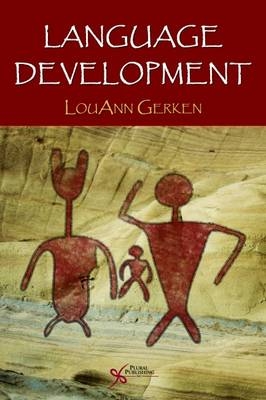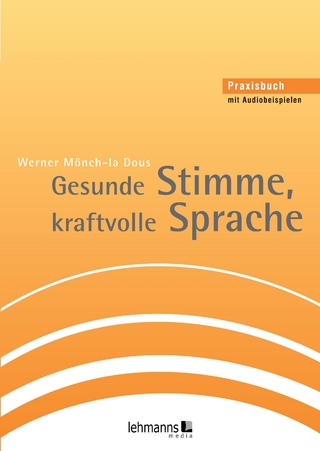
Language Development
Plural Publishing Inc (Verlag)
978-1-59756-263-8 (ISBN)
The English word infant is derived from the Latin word meaning unable to speak, reflecting the general sense that the transition from infancy into childhood is marked by the production of the child's first word. However, modern methods for measuring infant behavior and brain activity suggest that there is a great deal of language learning that goes on before first word production. The book, Language Development, by LouAnn Gerken, Ph.D. examines both classic and current studies that trace the development of human language from before birth to the early childhood years. By focusing on areas of language development in which a unified set of theoretical issues has been explored, the book presents a theoretically and empirically more coherent approach to language development than other books in this discipline. The book also considers the theoretical questions that drive language scientists to pursue these studies: What are the biological underpinnings of language? Why has it proven so difficult to build a computer that learns language? Is language learning like or unlike learning of other abilities such as math or music? How should we best characterize developmental language disorders?This book is aimed at the junior and senior undergraduates and the graduate students enrolled in Language Development across psychology, linguistics, and communication disorders.
For practitioners engaged in working with language development/disorders, this is the perfect book to "stay up-to-date." Each chapter in this book includes valuable highlights of "thought questions" to help students ponder the content of the chapter. Lucid narration of contents has been significantly augmented by ample usage of tables and illustrations.
LouAnn Gerken, Ph.D. LouAnn Gerken received her Ph.D. in Psychology from Columbia University in 1987. She has held faculty appointments in Psychology, Linguistics, and Speech, Language and Hearing Sciences, and she is currently the Director of Cognitive Science at the University of Arizona. Throughout her career, she has used a range of techniques to study language development in infants and children, and has directed her research at addressing both practical issues and classic questions about the nature of human language and its relation to the human mind. In addition to her work on language development, Dr. Gerken is involved in efforts to restructure academic institutions to promote broader participation and greater equity.
Chapter 1. Introduction Why Study Language Development? The Nature of Language Meaning Units Combinable Meaning Units Combinable Submeaning Units The Combinatorial System Used in Human Language Phonology (Submeaning Units) Lexical Semantics (Meaning Units) Morphology and Syntax Grammar Theories of Language Development What Are We Trying to Explain? Why Are Theories Important? Overview of the Theories Ruling Out an Unconstrained Learner Associative Learning - Making Connections Among Experiences Hypothesis Testing - The Learner as Scientist Triggering - A Minimal Role for Experience Summary of Theories Organization of the Book Chapter 2. Overview of Phonology What Is Phonology? Segmental Phonology Phones and Phonemes A Note About Notation Articulatory Features Acoustic Manifestations of Articulatory Features Variability in Acoustic Manifestations of Articulatory Features Orderings of Phonemes Prosody Summary Chapter 3. Phonological Perception Prenatal Speech Perception Infant Speech Sound Discrimination Early Exploration Some Puzzling Findings Lead to a Reananlysis How Does Speech Perception Change Over Development? Finding Phonological Patterns in Auditory Words Phonological Perception of Words Summary Chapter 4. Phonological Production Precursors to Linguistic Production Oral Babble Manual Babble Protowords and Early Words Sound Properties of Early Words Early Words by Signing Children The Relation of Children's Early Words Productions and Adult Forms Substitution Processes Assimilation Processes Syllable and Word Shape Processes Other Important Relations Between Adult and Child Forms Theories of the Relation Between Adult and Child Forms Perceptual Theories Articulatory Theories Innate Phonology Theories Experience with the Target Language Theories Summary of Theories of the Relation Between Adult and Child Forms Prosodic Properties of Early Productions Language Disorders Involving Phonology Disorders Involving the Production of Consonants and Vowels *:Disorders Involving the Production of Prosody Summary Chapter 5. The Lexicon What Is the Lexicon? The Segmentation Problem Single-Word Utterances Words at Ends of Utterances Statistical Cues Occurrence of Words Adjacent to Frequent Function Morphemes Language-Specific Stress Patterns Language-Specific Typical Sound Sequences The Mapping Problem The Whole Object Assumption The Taxonomic Assumption The Mutual Exclusivity Assumption The Shape Bias Statistical Constraints Syntactic Constraints Children's Mapping Errors The Mapping Problem Across Languages Summary Chapter 6. Overview of Syntax and Morphology What Is Morphosyntax? Four Components of Morphosyntax Syntactic Constituents Syntactic Categories Structural Positions Thematic Roles Four Debates Concerning the Development of Morphosyntax Far Do Children Generalize from Morphosynctactic Input? Can Associative Learning Models Account for Generalization? Do Children Make Generalizations That Are Not Supported by the Input? Do Children's Morphosyntactic Errors Reflect Possible Human Grammars? Summary Chapter 7. Children's Sensitivity to Sentence Forms Syntactic Constituents Syntactic Categories Children's Early Utterances as Evidence for Syntactic Categories Children's Use of Distributional Cues to Discover Syntactic Categories Are Syntactic Categories Innate? Word Order Word Order in Child Production Word Order in Infant Perception Phrase Order in Infant Perception Summary Chapter 8. Assigning Meaning to Sentence Forms and Four Debates About Morphosyntactic Development Assigning Thematic Roles Using Word Order to Assign Thematic Roles Using Sentence Type to Assign Thematic Roles Using Morphological Case Markers to Assign Thematic Roles Learning the Thematic Role Requirements of Particular Verbs Summary of Assigning Thematic Roles to Structural Positions **How Far Do Children Generalize from Morphosyntactic Input? Can Associative Learning Models Account for Generalization? Past Tense Overgeneralization Children's Generalization of Abstract Patterns Do Children Make Generalizations That Are Not Supported by the Input? Hierarchilcal Structure in Question Format Anaphoric One Do Children's Morphosyntactic Errors Reflect Possible Human Grammars? English-Speaking Children's Subjectless Sentences Children's Pronoun Case Errors Summary of Children's Morphosyntactic Errors Summary Chapter 9. Issues in the Biology of Language We Need More Data What Do We Know so Far? The Raw Materials for Language Learning About the Form of the Input Mapping Forms to Meanings The Development of Language in Two Atypical Populations Specific Language Impairment Williams Syndrome Summary of Two Atypical Populations Age Effects on Language Learning Age Effects in Second Language Learning Age Effects in First Language Learning Creating Language Structure Summary Chapter 10. Some Methods Used in Language Development Research Some Behavioral Methods Focusing on Infant Form Discrimination Contingent Sucking Rate Procedure High Amplitude Sucking Procedure Headturn Preference Procedure Central Fixation Preferential Listening Procedure Visual Habituation Procedure Conditioned Head Turn Procedure Behavioral Methods Focusing on Infants' Ability to Associate Form and Reference Intermodal Preferential Looking Procedure Looking While Listening Procedure Switch Procedure Methods Measuring Brain Activity Event-Related Potentials Magnetoencephalography (MEG) Functional Magnetic Resonance Imaging (fMRI) Near Infrared Spectroscopy (NIRS) Methods for Testing Child Comprehension and Sensitivity to Morphosyntax Picture Selection Procedure Act-Out Procedure Grammaticality Judgments Truth-Value Judgments Methods for Testing Language Production Spontaneous Speech Imitative Speech Elicited Production Index
| Zusatzinfo | b/w illustrations |
|---|---|
| Verlagsort | San Diego |
| Sprache | englisch |
| Maße | 152 x 229 mm |
| Gewicht | 363 g |
| Themenwelt | Geisteswissenschaften ► Sprach- / Literaturwissenschaft ► Sprachwissenschaft |
| Medizin / Pharmazie ► Gesundheitsfachberufe ► Logopädie | |
| ISBN-10 | 1-59756-263-7 / 1597562637 |
| ISBN-13 | 978-1-59756-263-8 / 9781597562638 |
| Zustand | Neuware |
| Haben Sie eine Frage zum Produkt? |
aus dem Bereich


